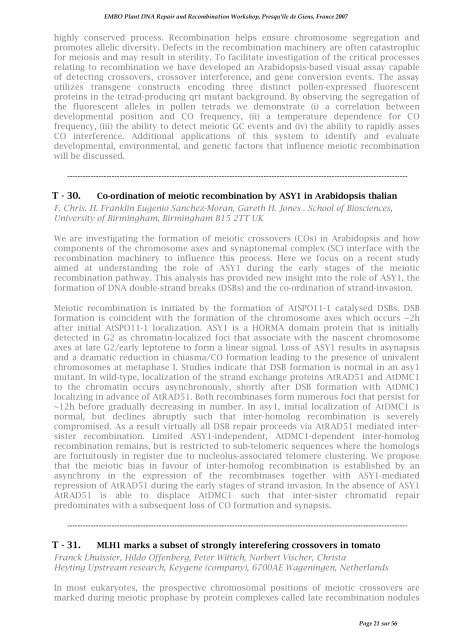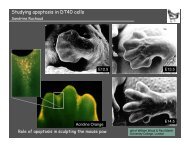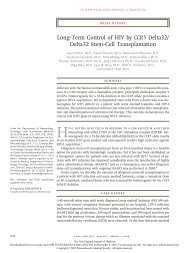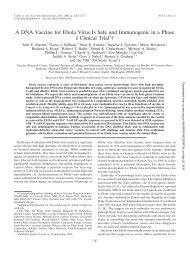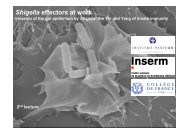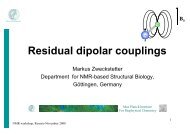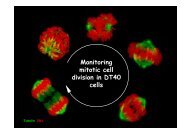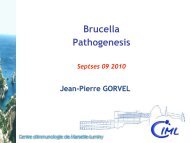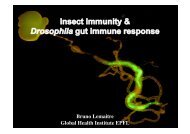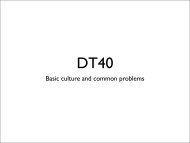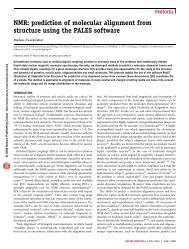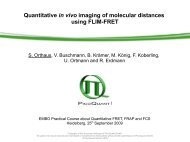pdf file - Events - EMBO
pdf file - Events - EMBO
pdf file - Events - EMBO
You also want an ePaper? Increase the reach of your titles
YUMPU automatically turns print PDFs into web optimized ePapers that Google loves.
<strong>EMBO</strong> Plant DNA Repair and Recombination Workshop, Presqu'île de Giens, France 2007<br />
highly conserved process. Recombination helps ensure chromosome segregation and<br />
promotes allelic diversity. Defects in the recombination machinery are often catastrophic<br />
for meiosis and may result in sterility. To facilitate investigation of the critical processes<br />
relating to recombination we have developed an Arabidopsis-based visual assay capable<br />
of detecting crossovers, crossover interference, and gene conversion events. The assay<br />
utilizes transgene constructs encoding three distinct pollen-expressed fluorescent<br />
proteins in the tetrad-producing qrt mutant background. By observing the segregation of<br />
the fluorescent alleles in pollen tetrads we demonstrate (i) a correlation between<br />
developmental position and CO frequency, (ii) a temperature dependence for CO<br />
frequency, (iii) the ability to detect meiotic GC events and (iv) the ability to rapidly asses<br />
CO interference. Additional applications of this system to identify and evaluate<br />
developmental, environmental, and genetic factors that influence meiotic recombination<br />
will be discussed.<br />
----------------------------------------------------------------------------------------------------------------------------------<br />
T - 30. Co-ordination of meiotic recombination by ASY1 in Arabidopsis thalian<br />
F. Chris. H. Franklin Eugenio Sanchez-Moran, Gareth H. Jones . School of Biosciences,<br />
University of Birmingham, Birmingham B15 2TT UK<br />
We are investigating the formation of meiotic crossovers (COs) in Arabidopsis and how<br />
components of the chromosome axes and synaptonemal complex (SC) interface with the<br />
recombination machinery to influence this process. Here we focus on a recent study<br />
aimed at understanding the role of ASY1 during the early stages of the meiotic<br />
recombination pathway. This analysis has provided new insight into the role of ASY1, the<br />
formation of DNA double-strand breaks (DSBs) and the co-ordination of strand-invasion.<br />
Meiotic recombination is initiated by the formation of AtSPO11-1 catalysed DSBs. DSB<br />
formation is coincident with the formation of the chromosome axes which occurs ~2h<br />
after initial AtSPO11-1 localization. ASY1 is a HORMA domain protein that is initially<br />
detected in G2 as chromatin-localized foci that associate with the nascent chromosome<br />
axes at late G2/early leptotene to form a linear signal. Loss of ASY1 results in asynapsis<br />
and a dramatic reduction in chiasma/CO formation leading to the presence of univalent<br />
chromosomes at metaphase I. Studies indicate that DSB formation is normal in an asy1<br />
mutant. In wild-type, localization of the strand exchange proteins AtRAD51 and AtDMC1<br />
to the chromatin occurs asynchronously, shortly after DSB formation with AtDMC1<br />
localizing in advance of AtRAD51. Both recombinases form numerous foci that persist for<br />
~12h before gradually decreasing in number. In asy1, initial localization of AtDMC1 is<br />
normal, but declines abruptly such that inter-homolog recombination is severely<br />
compromised. As a result virtually all DSB repair proceeds via AtRAD51 mediated intersister<br />
recombination. Limited ASY1-independent, AtDMC1-dependent inter-homolog<br />
recombination remains, but is restricted to sub-telomeric sequences where the homologs<br />
are fortuitously in register due to nucleolus-associated telomere clustering. We propose<br />
that the meiotic bias in favour of inter-homolog recombination is established by an<br />
asynchrony in the expression of the recombinases together with ASY1-mediated<br />
repression of AtRAD51 during the early stages of strand invasion. In the absence of ASY1<br />
AtRAD51 is able to displace AtDMC1 such that inter-sister chromatid repair<br />
predominates with a subsequent loss of CO formation and synapsis.<br />
----------------------------------------------------------------------------------------------------------------------------------<br />
T - 31. MLH1 marks a subset of strongly interefering crossovers in tomato<br />
Franck Lhuissier, Hildo Offenberg, Peter Wittich, Norbert Vischer, Christa<br />
Heyting Upstream research, Keygene (company), 6700AE Wageningen, Netherlands<br />
In most eukaryotes, the prospective chromosomal positions of meiotic crossovers are<br />
marked during meiotic prophase by protein complexes called late recombination nodules<br />
Page 21 sur 56


